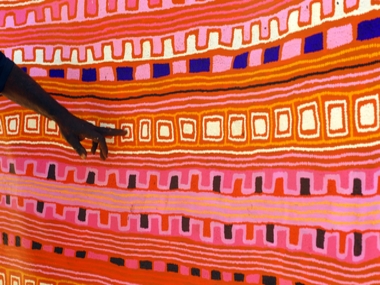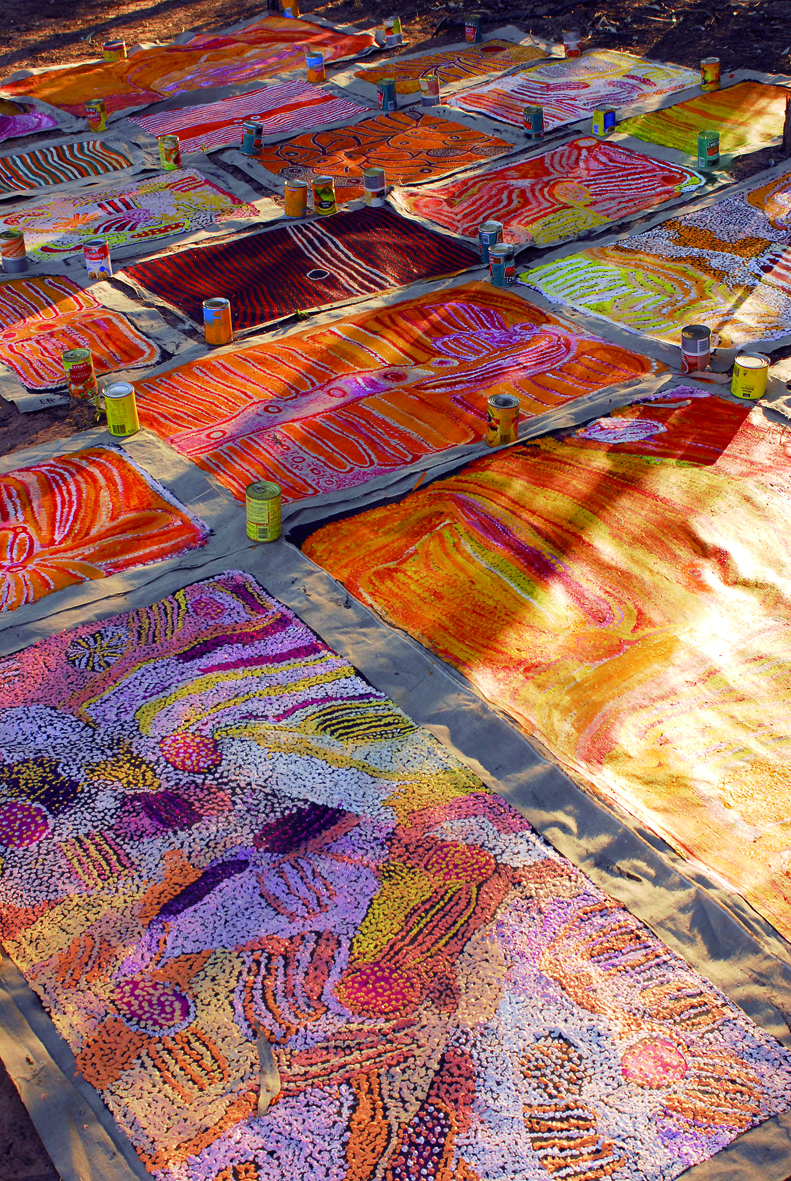MIRACLE ON THE CANNING

Canning Stock Route Country 2007 - a masterpiece by Patrick Olodoodi Tjungurrayi, whose hand points to the line of the CSR set against the multiple tracks of the Tingarri jukurrpa. Photograph by Tim Acker, 2007
Posted by Jeremy Eccles | 12.10.10
Gallery: National Museum of Australia
Dates:
17.12.11
: 29.04.12
It was rumoured a couple of years ago that an anthropologist was about to make the astounding announcement that he'd traced the three Aboriginal grandparents who'd lived on the Canning Stock Route (CSR) earlier last century and sired most of the great artists we know today across The Kimberley. For it's a little known fact that many people now living in an arc from Bidyadanga on the coast below Broome across to Warmun and Kununurra in the East Kimberley actually originated way down in the Deserts (Gibson, Great and Little Sandy) to the south. They'd then spent the 30s, 40s and 50s moving north to escape drought, inter-tribal wars and white intrusion, also attracted by tales of work and regular food on the cattle stations up north.
I'd got excited about these stories as long as 15 years ago when I first discovered that the glorious oranges and pinks of Eubena Nampitjin's Balgo paintings were telling the same stories as some of Rover Thomas's empty ochred spaces about the Well 33 region (Kunawarritji) on the CSR – where they were both born. Later I discovered that Warmun's Rover was a full brother to Stumpy Brown at Fitzroy Crossing, and she'd been inspired to paint her colourful memories of childhood by his pioneering efforts.
Now a 5 year project which has culminated at the National Museum in Canberra has told this whole amazing story of 'Yiwarra Kuju – The Canning Stock Route' - though the anthropological rumour hasn't quite been substantiated. True, one elder, Mikapa, can lay claim to Rover and Stumpy and their siblings' offspring, Clifford Brooks and Mary Meribada; also an in-law's offspring Jewess James and Wendy Wise. A second progenitor, Wankirri has Dulcie Gibbs and Jeffrey James to his name. And the third, Jatirti can claim Jakayu Bijabu, Eubena and her daughter Jane Gimme. But it's only when Eubena becomes the great Wimmitji Tjapangarti's second wife that we get tenuous links to a torrent of artistic talent – including Nora Wompi, Patrick Olodoodi and Helicopter Tjungurrayi, Bidee Baadjo, Mr Giles and his niece, Elizabeth Nyumi.
In all, 129 artists from 11 language groups became involved in the Project – producing 190 artworks specifically related to the CSR, giving 120 interviews on 200 hours of film and being subjected to 20,000 photos! The NMA exhibition is limited to 127 artworks – but it's no whip-around because, being a museum, there's a mass of supporting information in the darkened hall that's attached to each image – just the sort of thing I would have liked in the National Gallery's new spaces. What the NGA gets right is the natural light to see the art in; while the NMA illuminated brilliant paintings as though they were digital reproductions. Wacky!
Water is at the heart of each story. For the Kiyajarra, Putijarra, Kartujarra, Warnman, Manyjilyjarra, Kukatja, Wankajunga, Yulparija, Juwaliny, Jaru and the Walmajarri people, it was jila, the springs of living water created by ancestral beings (also jila) who shaped the land, created ceremonies and then turned into Kalputu – rainbow serpents – and disappeared down the holes that would become wells. Many were also associated with the women's Seven Sisters Dreaming. No wonder the Aborigines were devastated by Alfred Canning's mechanisation of the water supply which they believed certainly killed Kulyayi the jila at Well 42. Uncounted numbers of tribesmen were killed too as misunderstandings multiplied between such alien cultures. And Aborigines continue to worry about threatened mining at Wirnpa – Well 38.
The depressing fact is that Canning's stock route through what the explorer Carnegie called “the most dismal heartbreaking country it is possible to travel” probably only saw 25 cattle drives from the Kimberley to the markets of the south between 1911 and 1959 when it was officially abandoned. Did anyone celebrate the white centenary of the CSR's completion in April this year?
But the joyous 'return to country' journeys – including one 14-vehicle convoy - that the CSR Project initiated for artists to return to their Ngurra – home and ancestral places - have born rather more fruit. Apart from great art bought by the NMA as a collection, there are all those records, there's been a sharing of knowledge across the generations as young indigenous curators and film-makers became involved, and there were ceremonies for the country revived that needed the first-hand contact with it to occur.
Did the Project also inspire the confidence of young curator, Doolmarria Mengil to declare: “We are different, and we're never going to be the same; this is our story about the CSR and this is how we're telling it”.
Credit for all this goes to FORM, the WA organisation propelled by the Ackers – Tim and Carly Davenport – who have ensured that a really Big Project didn't go off half-cock, and will remain permanently on the record thanks to a fine catalogue.
And last year's exhibition opening in Canberra has been followed by a trip to Perth for the Commonwealth Heads of Government Meeting and now, a stay in Sydney at the Australian Msueum.
Still work to do, of course. I would argue that there's an unexplored trove of research material in the Axel Poignant photographic archive from the trip he made up the Canning in 1942. Just as Norman Tindale inadvertently photographed the future art masters Johnny Warangkula and Mick Namarrari as kids, so Poignant must have caught some of the future artists in Yiwarra Kuju at the same time as he took his prize-winning Mary – an unnamed Aboriginal mother and breast-feeding child.
Perhaps somebody also needs to examine the irony that a Dreaming and cattle track created around water supply failed both Black and White people last century – leaving just one community extant at that rich source-place of artists, Well 33, Kunawarritji.
URL: www.australianmuseum.net.au
Share this:
»  del.icio.us
»
del.icio.us
»  Digg it
»
Digg it
»  reddit
»
reddit
»  Google
»
Google
»  StumbleUpon
»
StumbleUpon
»  Technorati
»
Technorati
»  Facebook
Facebook
Contact Details
Gallery: National Museum of Australia
Email: information@nma.gov.au
Telephone: +61 2 6208 5000
Address: Lawson Crescent Acton Peninsula Canberra 2600 ACT
Gallery: Australian Museum
Telephone: +61 2 9320 6000
Address: 6 College Street Sydney Sydney 2010 NSW

The Canning Stock Route collection laid out on the shores of Nyarna (Lake Stretch. Photograph by Tim Acker, 2007
Where is the exhibition?
Further Research
Gallery: National Museum of Australia
Artists: Bidee Baadjo | Clifford Brooks | Elizabeth Nyumi | Eubena Nampitjin | Helicopter Tjungurrayi | Jakayu Bijabu | Jane Gimme | Johnny Warangkula | Mary Meribada | Mick Namarrari | Mr Giles | Nora Wompi | Patrick Olodoodi Tjungurrayi | Rover Thomas
News Tags: Australian Museum | Axel Poignant | Canning Stock Route | Carly Devonport | FORM | National Museum of Australia | Tim Acker
News Categories: Australia | Other Event
Exhibition Archive
- 10.10.17 | TARNANTHI 2017
- 11.08.17 | Natsiaas 2017
- 20.07.17 | APY ART DOMINATES THE WYNNE
- 17.07.17 | Anangu Artist Wins $100,000 Prize
- 14.07.17 | The End of AAMU
- 11.07.17 | ART ACROSS THE COUNTRY
- 11.07.17 | TARNANTHI IN OCTOBER
- 05.07.17 | TJUNGUṈUTJA - from having come together
- 13.06.17 | Ghost-Nets Straddle the World
- 07.06.17 | Grayson Perry Going Indigenous?
- 05.06.17 | Barks Bigger than Ben Hur
- 27.05.17 | NGA QUINQUENNIAL 2017
- 21.05.17 | Blak Douglas Finds Home at the NGA
- 21.05.17 | BRIAN ROBINSON WINS HAZELHURST WOP
- 18.05.17 | PARRTJIMA 2.0
Advertising

